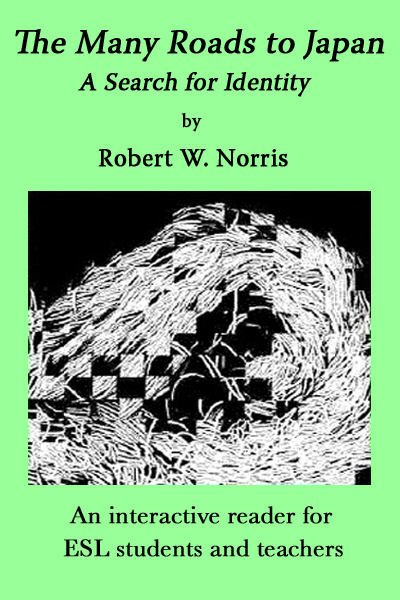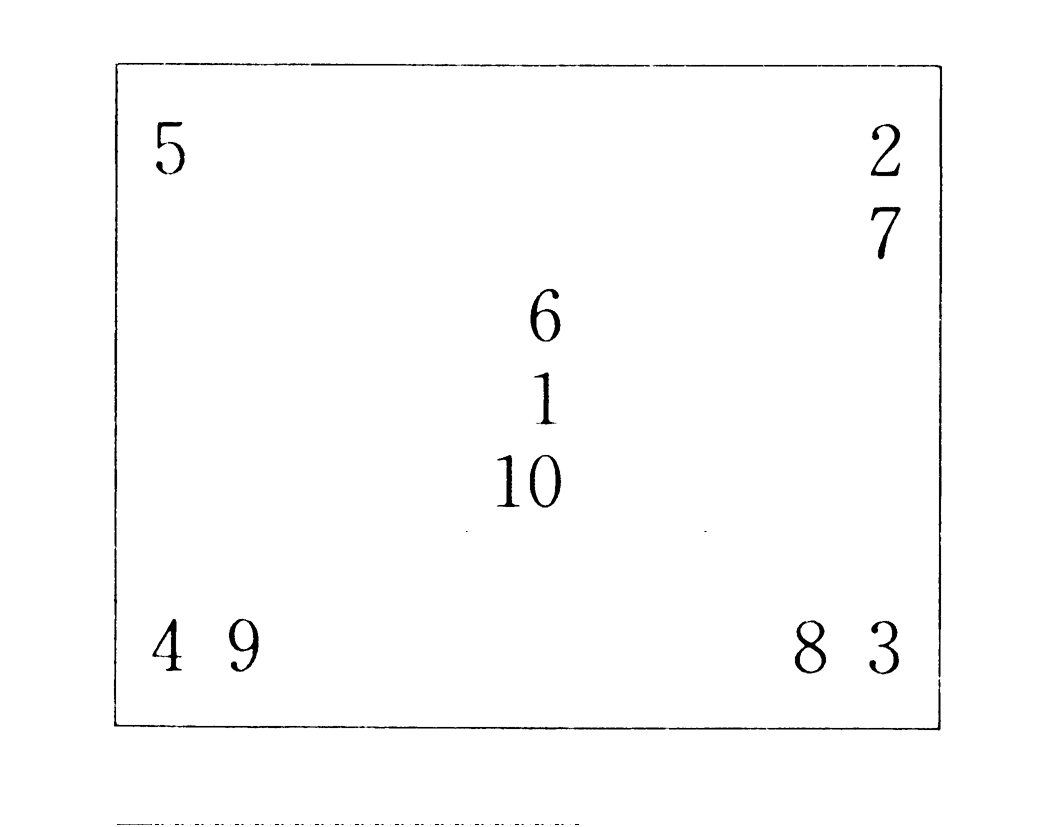
Home About Robert CV The Good Lord Willing and the Creek Don't Rise: Pentimento Memories of Mom and Me Novels Reviews ESL Papers (can be viewed online by clicking on titles) The Many Roads to Japan (free online version for ESL/EFL teachers and students) Contact     |
Robert W. Norris 1992. In Fukuoka Women's Junior College Studies Vol. 44: 95-104 Introduction One of the most difficult problems facing Japanese junior college and university students of English is the use of the articles "a" and "the." These students often can formulate grammatical definitions for definite and indefinite articles, as well as cite a few rules governing their usage, but when it comes to actual production of these two troublesome words in speech or in writing, the students seem to all but throw up their hands in despair. This paper offers teachers a possible solution for helping students overcome their difficulties in acquiring a working knowledge of "a" and "the." This solution is divided into four parts: (1) understanding why articles are so difficult for the students, (2) understanding the type of grammatical knowledge the students possess, (3) raising students' cognitive consciousness through simple extended descriptions, and (4) using visuals for promoting meaningful learning in production exercises. Why are Articles So
Difficult?
One reason English articles present so much difficulty to ESL/EFL (English as a second/foreign language) students is the vastness and complexity of the rules and exceptions governing article usage. Cromwell (1964: 38) writes, "Every student of English has my sympathy in his struggles with the articles 'a,' 'an,' and 'the.'" then goes on to detail 16 pages of rules and exceptions. In one ESL text, Robinson (1967) lists 44 separate rules. Quirk, et al. (1985) go even further, spending 32 pages on article usage. In addition to the many rules and exceptions of the English article system, the Japanese student of English is also burdened by the fact that there is no grammatical equivalent to articles in her own native language. In an analytical study of structural errors found in 632 English compositions written by Japanese students in American high schools and junior colleges, Kimizuka (1967) found more mistakes in article usage than in any other structural category. Kimizuka (1967: 78-79) explains this phenomenon:
What Do the Students Know?
Japanese students at the junior college and university level bring with them a great deal of passive knowledge and little experience in applying that knowledge to anything outside of discrete-point grammar test questions. Dissosway (1989: 13) elaborates on this background:
Consciousness-Raising and Meaningful Learning
Before describing the author's lesson plans for teaching "a" and "the," it is important to first have an understanding of what is meant by grammatical consciousness-raising. Rutherford and Smith (1988: 3) say:
In other words, teachers of Japanese junior college and university students should use the students' passive knowledge as both a starting point and a springboard for giving extended descriptions and meaningful practice of the structures the students are in the process of acquiring. Visuals and Imagery
Psychological and psychologically-oriented experimental research seems to indicate that for all types of learners the maximum use of extra visual devices is necessary for unimpeded effective learning to take place (Smith, 1988). Maximizing visual representations to accompany, illustrate, and explain linguistic items may well improve learning a great deal, especially where the content is too abstract to expect the learner to grasp a verbal explanation of a grammatical item. Stevick (1986: 50-51) extends this importance of visuals to his usage of the word "image":
A Rod Lesson
Keeping in mind the background of the students we are teaching, the passive knowledge they possess, the basic principles of CR and extended descriptions, and the effectiveness of using visuals and imagery to enhance learning, we now turn to some plans for teaching the rudiments of the articles "a" and "the." This first plan involves using a box of cuisenaire rods. For this particular lesson plan, the rods serve four main purposes:
Next, the teacher puts three rods in the box, goes to another student, and elicits "take a rod," "take another rod," and "take the other rod." He then puts two rods in the box, goes to another student, and elicits "take a rod," and "take the other rod." He puts one rod in the box, goes to a different student, and elicits "take the rod." Finally, he puts several rods in the box, goes to another student, tells her to take all the rods, and elicits, "take the rods." During this phase there is usually a lot of confusion and guessing among the students. The teacher remains nonjudgmental about their guesses. He simply refuses to allow them to take the rods until the correct answer is forthcoming. The teacher goes to the board and writes the following extended descriptions:
The teacher repeats the "Where is the rod?" questioning for each of the four corners, making sure the students understand the use of "the" in "in the top right corner," "in the bottom left corner," etc. Next, the class is divided into groups of four or five students. A shoebox lid is placed upside down before each group. This is preferable to a book or piece of paper in order to prevent confusion about the use of "in" (as opposed to "on"). Each student is assigned a role with in her group: "action person," "___ing question person," "___ing answer person," "past-tense question person," and "past-tense answer person." In groups of four, the "action person" can also take the role of "past-tense answer person." Each group is given ten rods (two red, two blue, two green, one yellow, and three white). The lesson now turns into a Total Physical Response (TPR) exercise with students carrying out the following five commands:
After these five commands and the questioning and answering have been completed, the teacher points to each of the five rods and asks, "Which rod is this?" The students are guided to use relative clauses in answering "It is the rod which is in the center/top right corner/etc. of the box." The teacher asks why "the" is used in front of "rod." After eliciting "the only one in the center/top right corner/etc.," the teacher adds "the one(s) that exist in a particular space" to the extended description of "the" written earlier on the board. After some review of locative prepositions and making sentences such as "It is to the right of the rod which is in the bottom left corner of the box," the teacher continues the TPR lesson with these new commands:
7. Take the other green rod and put it under the rod which is in the top right corner of the box. 8. Take a blue rod and put it to the left of the rod which is in the bottom right corner of the box. 9. Take the other blue rod and put it to the right of the rod which is in the bottom left corner of the box. 10. Take the yellow rod and put it under the rod which is in the center of the box. The teacher also writes the words "first," "next," and "finally" on the board. The students are told to tell the story chorally of what they have done. For example, "First we put a red rod in the center of the box. Next, we...." When finished, the students write the ten steps. The teacher collects the papers, corrects any mistakes, and hands them back in the next class. Picture Lessons
In following classes, the teacher reviews the extended descriptions for "a" and "the," hands out copies of pictures, and has the students write sentences about the pictures. One possibility is using picture differences. Working in groups, the students must find the differences and write sentences describing the differences. For example, "In the first picture the man who is in the top left side has long hair, but in the second picture he has short hair." In this picture difference lesson, the teacher walks around giving personal assistance where necessary. Various grammatical problems invariably arise, but the fundamental focus should be on the students' article usage, with the teacher guiding the students to use their own knowledge, to test out their own hypotheses, and to make their own discoveries. Another picture lesson uses one "before" picture (showing a dirty room) and one "after" picture (showing the same room after it has been cleaned). The teacher reviews the extended descriptions of "a" and "the," then adds this new criteria:
After the students complete about ten sentences, each beginning with "The (window/bed/books/etc.)," they are given the "after" picture, which should contain at least two new items that were not in the "before" picture. The students are told to write sentences about what has been done to the room. The teacher gives one sample sentence: "The window has been opened." The teacher makes no further reference to the new criteria for using articles, but does tell the students he knows nothing about the second picture. He has information about just the first picture. The object of this lesson is to guide the students toward discovering on their own that they must use "a" for the new items (i.e., new information) in the second picture, as in "A painting has been hung on the wall" and "A tablecloth has been put on the table." It is crucial the teacher not explicitly explain the correct answers. The students must be allowed to produce them on their own. This is in keeping with the concept of meaningful learning as opposed to rote learning. A Composition Lesson
After two or three lessons using pictures, the students can next be asked to apply their knowledge in a two- or three-page story. The author has found that providing a simple list of writing guidelines and the first paragraph both focuses the students' grammatical consciousness and stimulates their imagination. The writing guidelines and lead paragraph the author has used most often in his eisakubun (writing) classes are listed below:
After the rough drafts are completed, students exchange papers and check for errors based on the writing guidelines they have been given. Final drafts are then written and handed in to the teacher. Conclusion
This paper has examined why English article usage is so difficult for Japanese students, the type of grammatical knowledge they possess at the junior college and university level, and a plan for raising students' grammatical consciousness of articles through extended descriptions, meaningful learning, and the use of visuals and imagery in structural and composition practice. The author has found that it is also possible to use CR techniques for several grammatical problem areas simultaneously within a single lesson. For example, in the rod lesson not only can practice of articles be accomplished, but also practice of locative prepositions, relative clauses, transitive verbs, and object pronouns. It is simply up to the teacher to establish the focal areas and the depth of the extended descriptions he chooses to use. Since the author began incorporating CR techniques into his eisakubun classes, he has seen a marked improvement in all grammatical areas covered, including the troublesome "be" verb. As was pointed out previously, the use of CR techniques is meant to be a means to an end rather than an end itself. It is intended to facilitate the acquisition of target language grammatical competence. The lessons and extended descriptions discussed in this paper are merely an introduction to the complexity of English article usage. Further refinements and new descriptions can be introduced step by step as students continue to make progress. When designing practice activities, the teacher should always be conscious of leading the students toward self-discovery and active application of the structures being learned. As long as decisions are involved, even if they are only semantic or concerned with syntactic processes already supposed to be known, then the students are forced, to some degree, to understand what they are doing, and in the process discover something about the structure in question. In using CR techniques to teach English article usage or any grammatical structure, a teacher needs to make a leap of faith to what Corder (1985) calls "a guided inductive approach." Corder (1985: 133) defines this phrase:
BIBLIOGRAPHY
Ausubel, D. 1968. Educational Psychology: A Cognitive View. New York: Holt, Rinehart and Winston. Bailey, K. and Celce-Murcia, M. 1979. Classroom Skills for ESL Teachers. In M. Celce-Murcia and L. McIntosh (Eds.), Teaching English as a Second or Foreign Language. Rowley, Mass.: Newbury House. Corder, S. 1988. Pedagogic Grammars. In W. Rutherford and M. Smith (Eds.), Grammar and Second Language Teaching. New York: Newbury House. Cromwell, T. 1964. Index to Modern English. New York: McGraw-Hill. Dissosway, P. 1989. Incorporating Grammar into University Writing Classes. The Language Teacher 8(6): 13-18. Kimizuka, S. 1967. Teaching English to Japanese. Los Angeles: Anchor Enterprises. Quirk, R., Greenbaum, S., Leech, G., and Svartvik, J. 1985. A Comprehensive Grammar of the English Language. London: Longman. Robinson, L. 1967. Guided Writing and Free Writing. New York: Harper and Row. Rutherford, W. and Smith, M. 1988. Introduction. In W. Rutherford and M. Smith (Eds.), Grammar and Second Language Teaching. New York: Newbury House. Smith, M. 1977. Aspects of Future Reference in a Pedagogical Grammar of English. Frankfurt/Main: Lang. ____1988. Applied Linguistics and the Psychology of Instruction: A Case for Transfusion? In W. Rutherford and M. Smith (Eds.), Grammar and Second Language Teaching. New York: Newbury House. Stevick, E. 1986. Images and Options in the Language Classroom. Cambridge: Cambridge University Press. |
